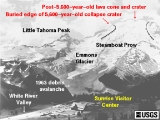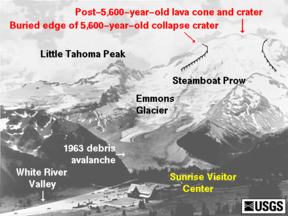
Emmons Glacier
Encyclopedia

Glacier
A glacier is a large persistent body of ice that forms where the accumulation of snow exceeds its ablation over many years, often centuries. At least 0.1 km² in area and 50 m thick, but often much larger, a glacier slowly deforms and flows due to stresses induced by its weight...
on the northeast flank of Mount Rainier
Mount Rainier
Mount Rainier is a massive stratovolcano located southeast of Seattle in the state of Washington, United States. It is the most topographically prominent mountain in the contiguous United States and the Cascade Volcanic Arc, with a summit elevation of . Mt. Rainier is considered one of the most...
, in Washington. At 4.3 square miles (11.1 km²), it has the largest surface area of any glacier in the contiguous United States
Contiguous United States
The contiguous United States are the 48 U.S. states on the continent of North America that are south of Canada and north of Mexico, plus the District of Columbia....
. The glacier was named after the geologist Samuel Franklin Emmons
Samuel Franklin Emmons
Samuel Franklin Emmons was an American Geologist. He was born in Boston, Massachusetts. He graduated from Harvard University in 1861 and studied at the Ecole des Mines in Paris, France from 1862–1864 and at the Frieberg mining school from 1865-1865. In May 1867, he was appointed assistant...
after his involvement in a survey of Mount Rainier in 1870.
Starting at an elevation of over 13800 feet (4,206.2 m), the Emmons glacier flows down eastward. Near the Disappointment Cleaver at 12200 feet (3,718.6 m), the Emmons is joined by the Ingraham Glacier flowing to the south. The glaciers flow together and remain connected until they split up upon reaching the wedge of Little Tahoma Peak. As the Emmons flows northeast, the massive glacier descends until it reaches its rocky lower terminus at about 5100 feet (1,554.5 m) in elevation.
In the 1930s, the glacier was found to be receding quickly. However, in 1963, a rock fall from Little Tahoma Peak covered the lower glacier with rock debris. The debris cover insulated the ice from melting. As a result of decreased melting, the glacier advanced rapidly in the early 1980s. That advance was continuing as of 1992, but at a slower rate; ice beneath the rock debris was melting irregularly and forming a vast hummocky area. By 2003, the glacier was again retreating.
Emmons Glacier is often used as a route (the Columbia Crest route) to climb to the summit of Mount Rainier.

